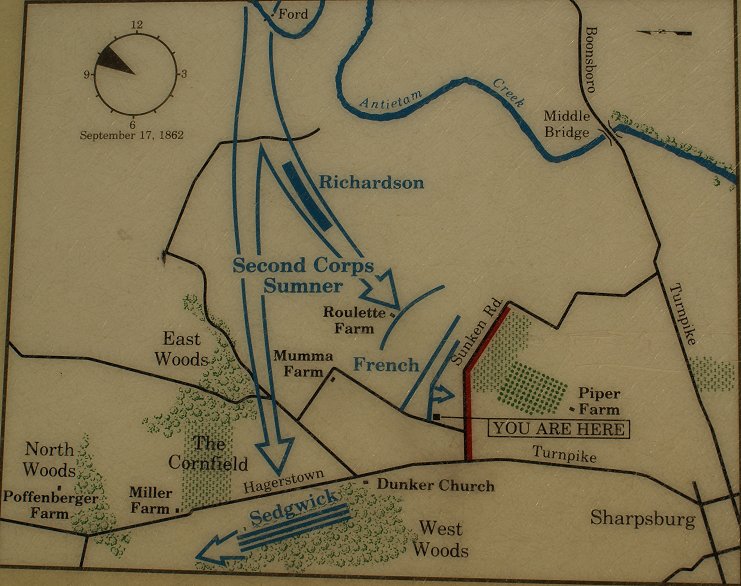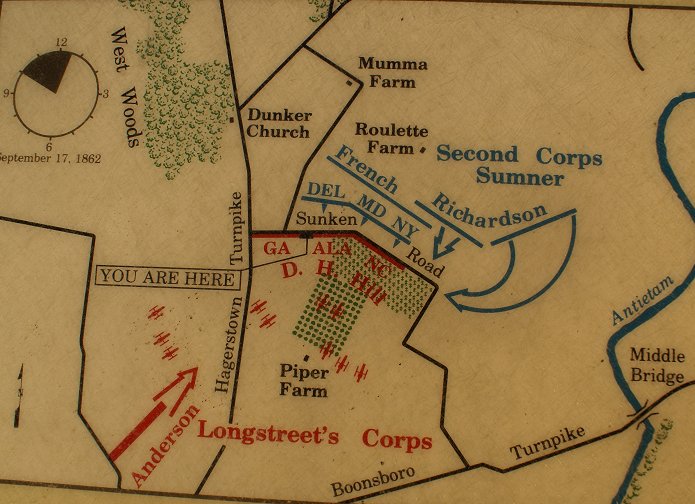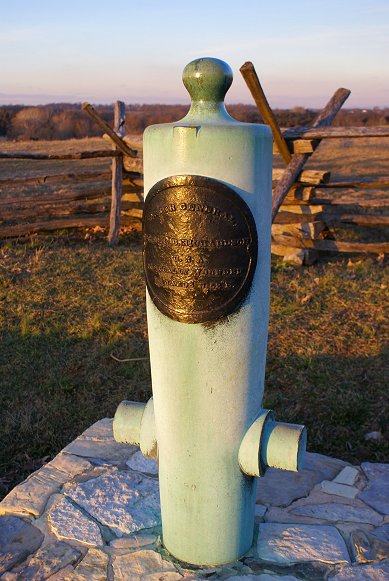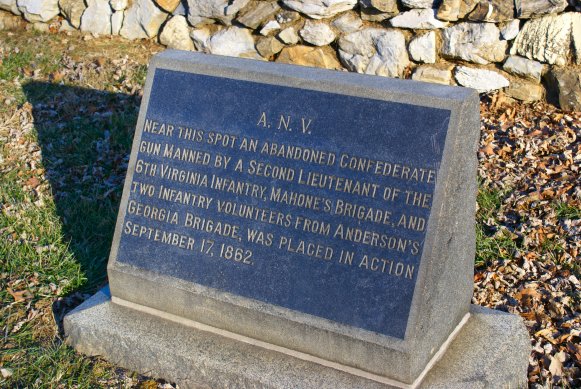
Antietam - II Corps Attacks, The Sunken Road
September 17, 1862
Daniel Harvey Hill's division had already intervened in the fluid battles near the East Woods, so even though it held a strong position in a sunken road, the division was somewhat weakened. The two remaining divisions of Sumner's corps were approaching the battlefield, and the sunken road would soon become the Bloody Lane. General Lee arrived to investigate and was told by Col. John B Gordon of the 6th Alabama that, "The men are going to stay here, General, till the sun goes down or victory is won!" By the end of the fight, Gordon was wounded six times, knocked out, and fell into his hat, which was filling with his own blood. Gordon would survive only because a hole had been blown into the hat, allowing the blood to drain.
Lee and DH Hill moved to higher ground behind the Sunken Road, where they were joined by Longstreet. Lee and Longstreet dismounted from their horses to inspect the enemy without drawing unnecessary attention. DH Hill, however, was recovering from an incident earlier in the day when a horse had been shot from underneath him, and he declined to a request from Longstreet to dismount. Longstreet asked the difficult General Hill to keep his distance - and prudently so. A flash came from Union artillery across Antietam Creek, and in a few seconds the two front legs of Hill's horse were blown off. A sore Harvey Hill struggled to extricate himself from the animal.

|
 |

From the Observation Tower
This is the view down the Sunken Road from the Park Service observation tower. French's division deployed generally between the Mumma and Roulette sites and advanced on the the Sunken Road. The Sunken Road beyond the bend at the group of trees was defended by Rodes' brigade. George Anderson's brigade defended the sunken road further to the right, closer to the foreground.

French Repulsed
Weber's brigade attacked and took a devastating volley at under 100 yards, then fell back behind the crest of the hill. A Confederate counter-attack, including one on the Union right flank from near the Visitors Center - the 8th SC of Kershaw's brigade - was beaten back. Morris's brigade in support continued the attack but made no progress. French committed his final brigade, that of Kimball. It, too, was repulsed. French's division lost 1,750 that day, around 30% of its strength, making it incapable of further attacks.

Richardson and Anderson Arrive
|
 |

Irish Brigade Attacks
Meagher's Irish Brigade was the first of Richardson's brigades to attack, just to the left of French. After pushing back Confederates trying to flank French's division, an attack on the sunken road was repulsed. Newly arriving Confederate units counter-attacked, but they, too, were repulsed. The Irish Brigade was badly cut up and was sent to the rear. Its place was taken by Caldwell's brigade. Caldwell had been on the extreme left of the line, overlapping the Rebel flank, but his movement to the center prevented any turning of the strong Confederate position.

Confusion in the Sunken Road
Caldwell pressed the attack. By that time, the sunken road had become too crowded with southerners to maintain order. Col. Carnot Posey ordered his brigade from the road to the rear to relieve the congestion. Confusion, however, was the result, with all of R.H. Anderson's division following them to the rear, then George Anderson's brigade also fell back - all of them taking heavy casualties in the process. Only two regiments were left in the right half of the sunken road. Francis Barlow, in command of the 61st and 64th NY, moved to get an enfilade fire on the two remaining Confederate regiments then advanced and captured around 300 men.

Rodes' Brigade In Confusion
On the left half of the Confederate sunken road line there was similar confusion. In the area on the right of this panorama, you can see how the road rises to nearly the level of the surrounding ground, making it vulnerable to Union fire. The road also turns slightly to the right, forming a salient. This area was held by the 6th Alabama, now under the command of Lt Col Lightfoot since the wounding of Gordon. Lightfoot explained the situation to Rodes, his brigade commander, and he was ordered to move the vulnerable men to the shelter of a lower portion of the sunken road. Misunderstanding this, Lightfoot ordered his men to the rear. Like the situation on the right flank with Posey, the retreat spread, with Rodes' entire brigade falling back and taking heavy in the process casualties.
The Confederates had lost the Sunken Road, leaving a pile of bodies in the process. The center of Lee's army was in confusion, and disaster was looming for the Southern cause.
Union Views:


These are views from in front of the Sunken Road - views only available in the cold season when crops are not being cultivated.

Cooke's Counterattack
Greene's division near the Dunker Church (between the visitors center and the West Woods) had been unaware of Sedgwick's disaster and remained in place. Greene was flanked on both sides and pushed back to East Woods. Cooke's brigade of 675 Confederates was ordered by Longstreet to advance to the Mumma farm to relieve pressure on the sunken road. Rodes' brigade was meant to cooperate but by this time it had already fallen back. So Cooke continued in a hopeless attack, capturing stragglers that they didn't take the time to disarm. Part of French's division, including the 14th Connecticut, and even some of Richardson's division, countered the move. Cooke was forced back, and during the retreat his men had to endure fire from their rear from their Federal prisoners. Cooke's Confederates formed line on the Hagerstown Pike.

To the Rear of the Sunken Road From Observation Tower
|
 |

Chamberlaine Gun
|
 |

Chamberlaine's New Position
From the new position Chamberlaine saw a Union attack on the Dunker Church. With a good shot down the attacking Union line, Chamberlaine pitched in with his gun. Soon, however, the Yankees would threaten him directly. Confederate infantry from the Sunken Road action rallied at some nearby rock outcroppings, likely the ones visible here. Union pursuers were hot on their heels. The Yankees went right for the gun, but the inexperienced gunners did effective work, repulsing three attacks and protecting the vital north/south Hagerstown Pike.

From Piper Barn
This is the view from near the Piper barn, with the house visible on the right. Desperate fighting continued in the orchard between the Piper's and the sunken road. (You can see the stone tower marking the location of the Sunken Road.) Eventually, though, Confederate artillery convinced the Yankees to withdraw behind their hard-fought gains at Bloody Lane. A great opportunity to puncture the Confederate line and drive Lee into the Potomac had been lost. But the battle wasn't over yet, and Burnside's IX Corps had not yet made a major effort. Despite lost opportunities, prospects for Union victory were still bright.
Copyright 2008 by John Hamill